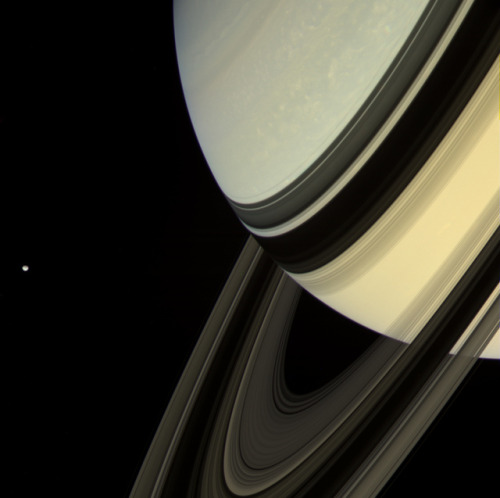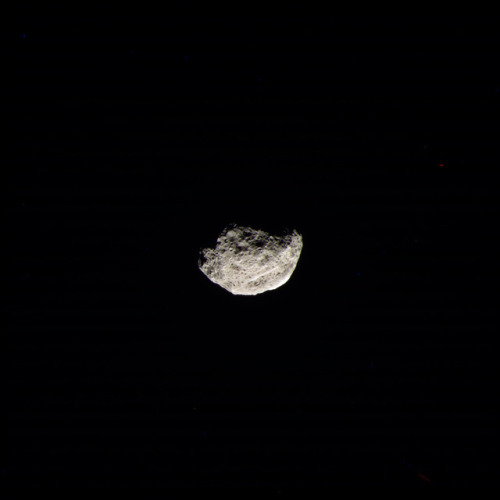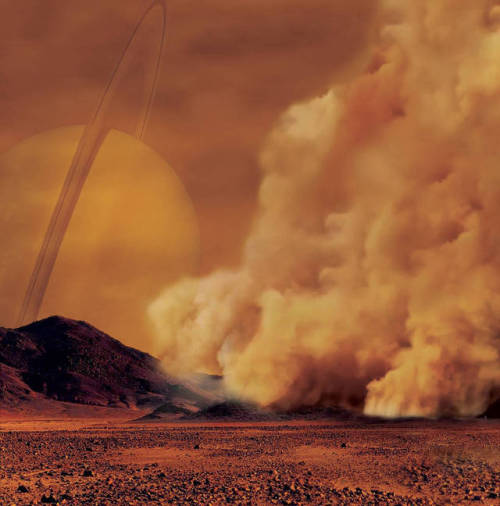Water Ice Clouds On Mars (desktop/laptop) Click The Image To Download The Correct Size For Your Desktop

Water ice clouds on Mars (desktop/laptop) Click the image to download the correct size for your desktop or laptop in high resolution
More Posts from Sharkspaceengine and Others




Pictures of the day - January 17, 2019
Colorful Titan-Like world with seas of liquid methane and a surface thriving with methane-based life, which give the planet it's unique coloring.
Space Engine System ID: RS 8550-3584-8-206537-286 8 to visit the planet in Space Engine.







Pictures of the day 2 - December 2, 2018
Insight System - Fourth Planet (Insight B-IV)
Insight B-IV is a Saturn-Like planet with an extensive tan-colored ring system. The planet is 53,870 kilometers in radius and has a mass of 62.7 Earth’s. This small gas giant orbits Insight B at an average distance of 0.56 AU and completes and orbit once every 184.9 Earth days. A day on the planet lasts 16 hours and 24 minutes.
Weather on the planet is quite active with numerous storm systems ranging across the planet constantly. The temperatures averages -94 F.
A total of 26 moons orbit Insight B-IV, but only one of those, the third satellite is a large rounded object. Its lone large moon has a radius of 1,132 kilometers, and a mass one quarter that of our moon.
High Resolution Pictures
Insight B-IV
Active atmosphere
Lonely moon
Duality
Insight B-IV-M3 (only large moon)
Lunar Surface
Between the rings






Pictures of the day - December 2, 2018
Insight System - Third Planet orbiting Insight B (Insight B-III)
Insight B-III is the giant of the Insight System, being the most massive planet of both of the system’s stars. It is a massive gas giant the nears the boundary with a brown dwarf at 11.75 Jupiter masses. The planet has an active atmosphere from both solar heating and internally released heat and has an average atmospheric temperature of 147 F.
The planet orbits the sun at an average distance of 0.21 AU, and completes an orbit once every 41.33 days. The planet is not quite tidally locked with a rotational rate of 41.67 days vs its orbital period of 41.33 days. As a result, a solar day on the planet lasts 14.00 Earth years.
No major satellites orbit the planet; however, 30 asteroid-like irregular satellites orbit the planet.
Note the star visible in the last picture is the Insight System’s primary star Insight A. Viewed from the gas giant, the star shines with an average magnitude of -17.29, bright enough that it illuminates the dark side of objects to approximately the same level of lighting as the average living room.
High Resolution Pictures
Insight B-III
Polar View
Crescent View
Equatorial Cloud Bands
Nearby asteroid moon
Distant asteroid moon










Saturn, rings and moons
NASA/JPL-Caltech/SSI/Kevin M. Gill

Dust Storms on Titan Spotted for the First Time
Data from NASA’s Cassini spacecraft has revealed what appear to be giant dust storms in equatorial regions of Saturn’s moon Titan. The discovery, described in a paper published on Sept. 24 in Nature Geoscience, makes Titan the third Solar System body, in addition to Earth and Mars, where dust storms have been observed.
The observation is helping scientists to better understand the fascinating and dynamic environment of Saturn’s largest moon.
“Titan is a very active moon,” said Sebastien Rodriguez, an astronomer at the Université Paris Diderot, France, and the paper’s lead author. “We already know that about its geology and exotic hydrocarbon cycle. Now we can add another analogy with Earth and Mars: the active dust cycle, in which organic dust can be raised from large dune fields around Titan’s equator.”

Titan is an intriguing world – in ways quite similar to Earth. In fact, it is the only moon in the Solar System with a substantial atmosphere and the only celestial body other than our planet where stable bodies of surface liquid are known to still exist.
There is one big difference, though: On Earth such rivers, lakes and seas are filled with water, while on Titan it is primarily methane and ethane that flows through these liquid reservoirs. In this unique cycle, the hydrocarbon molecules evaporate, condense into clouds and rain back onto the ground.

The weather on Titan varies from season to season as well, just as it does on Earth. In particular, around the equinox – the time when the Sun crosses Titan’s equator – massive clouds can form in tropical regions and cause powerful methane storms. Cassini observed such storms during several of its Titan flybys.

When Rodriguez and his team first spotted three unusual equatorial brightenings in infrared images taken by Cassini around the moon’s 2009 northern equinox, they thought they might be the same kind of methane clouds; however, an investigation revealed they were something completely different.
“From what we know about cloud formation on Titan, we can say that such methane clouds in this area and in this time of the year are not physically possible,” said Rodriguez. “The convective methane clouds that can develop in this area and during this period of time would contain huge droplets and must be at a very high altitude – much higher than the 6 miles (10 kilometers) that modeling tells us the new features are located.”
The researchers were also able to rule out that the features were actually on the surface of Titan in the form of frozen methane rain or icy lavas. Such surface spots would have a different chemical signature and would remain visible for much longer than the bright features in this study, which were visible for only 11 hours to five weeks.
In addition, modeling showed that the features must be atmospheric but still close to the surface – most likely forming a very thin layer of tiny solid organic particles. Since they were located right over the dune fields around Titan’s equator, the only remaining explanation was that the spots were actually clouds of dust raised from the dunes.

Organic dust is formed when organic molecules, formed from the interaction of sunlight with methane, grow large enough to fall to the surface. Rodriguez said that while this is the first-ever observation of a dust storm on Titan, the finding is not surprising.
“We believe that the Huygens Probe, which landed on the surface of Titan in January 2005, raised a small amount of organic dust upon arrival due to its powerful aerodynamic wake,” said Rodriguez. “But what we spotted here with Cassini is at a much larger scale. The near-surface wind speeds required to raise such an amount of dust as we see in these dust storms would have to be very strong – about five times as strong as the average wind speeds estimated by the Huygens measurements near the surface and with climate models.”

The existence of such strong winds generating massive dust storms implies that the underlying sand can be set in motion, too, and that the giant dunes covering Titan’s equatorial regions are still active and continually changing.
The winds could be transporting the dust raised from the dunes across large distances, contributing to the global cycle of organic dust on Titan and causing similar effects to those that can be observed on Earth and Mars. source
Double Moons

Picture of the Day - October 17, 2018
A double transit of two moons across the face of a giant ringed planet.

Picture of the Day 2 - October 17,2018
Another wider angle shot






Pictures of the Day - November 10, 2018
Three different desert worlds orbiting a bright red dwarf with surface shots. The star is roughly 10% the brightness of the sun, about as bright as you can get for a red dwarf. A common misconception is that red dwarfs are actually red in color. This is true only for the smaller dim ones, but most have a more orange to red-orange tint to them.
Unfortunately, I already left the system long before I could log the system ID.
High Resolution Pics
Picture 1
Picture 2
Picture 3
Picture 4
Picture 5
Picture 6








Sometimes I wonder how beautiful the Universe is, and we do not even have to go that far. Imagine seeing Neptune and Uranus from their moons…
Images: x, x, x, x, x, x, x (artist’s impression)
-
 laughingwiththestars liked this · 6 years ago
laughingwiththestars liked this · 6 years ago -
 theproblemswiththesky reblogged this · 6 years ago
theproblemswiththesky reblogged this · 6 years ago -
 theproblemswiththesky liked this · 6 years ago
theproblemswiththesky liked this · 6 years ago -
 tngbabe liked this · 6 years ago
tngbabe liked this · 6 years ago -
 16fahri liked this · 6 years ago
16fahri liked this · 6 years ago -
 cripple-cat liked this · 6 years ago
cripple-cat liked this · 6 years ago -
 brybry-love reblogged this · 6 years ago
brybry-love reblogged this · 6 years ago -
 brybry-love liked this · 6 years ago
brybry-love liked this · 6 years ago -
 daemondamian liked this · 6 years ago
daemondamian liked this · 6 years ago -
 speedrunner-fuchs-wulf liked this · 6 years ago
speedrunner-fuchs-wulf liked this · 6 years ago -
 ukelittles123 liked this · 6 years ago
ukelittles123 liked this · 6 years ago -
 fagdykefrank liked this · 6 years ago
fagdykefrank liked this · 6 years ago -
 felixthethief liked this · 6 years ago
felixthethief liked this · 6 years ago -
 croatoanpiano liked this · 6 years ago
croatoanpiano liked this · 6 years ago -
 megalunalexi-aesthetic liked this · 6 years ago
megalunalexi-aesthetic liked this · 6 years ago -
 pika-plushie liked this · 6 years ago
pika-plushie liked this · 6 years ago -
 niavirrivain liked this · 6 years ago
niavirrivain liked this · 6 years ago -
 sharkspaceengine reblogged this · 6 years ago
sharkspaceengine reblogged this · 6 years ago -
 sharkspaceengine liked this · 6 years ago
sharkspaceengine liked this · 6 years ago -
 mariliisa reblogged this · 7 years ago
mariliisa reblogged this · 7 years ago -
 laceysmile reblogged this · 8 years ago
laceysmile reblogged this · 8 years ago -
 pukeorama reblogged this · 8 years ago
pukeorama reblogged this · 8 years ago -
 howstrangethemusicsoundstome reblogged this · 8 years ago
howstrangethemusicsoundstome reblogged this · 8 years ago -
 howstrangethemusicsoundstome liked this · 8 years ago
howstrangethemusicsoundstome liked this · 8 years ago -
 solbacka liked this · 8 years ago
solbacka liked this · 8 years ago -
 eldiabloindisguise reblogged this · 8 years ago
eldiabloindisguise reblogged this · 8 years ago -
 holesinrealityy reblogged this · 8 years ago
holesinrealityy reblogged this · 8 years ago -
 ryoko368 reblogged this · 8 years ago
ryoko368 reblogged this · 8 years ago -
 ryoko368 liked this · 8 years ago
ryoko368 liked this · 8 years ago -
 hitchhikersguidetothemultiverse liked this · 8 years ago
hitchhikersguidetothemultiverse liked this · 8 years ago -
 i-inebriety liked this · 8 years ago
i-inebriety liked this · 8 years ago -
 maddeeloves liked this · 8 years ago
maddeeloves liked this · 8 years ago -
 kronos804 reblogged this · 8 years ago
kronos804 reblogged this · 8 years ago -
 tueofem reblogged this · 8 years ago
tueofem reblogged this · 8 years ago -
 edlnbmom-blog liked this · 8 years ago
edlnbmom-blog liked this · 8 years ago -
 soapbubbles54 reblogged this · 8 years ago
soapbubbles54 reblogged this · 8 years ago -
 realgarn liked this · 8 years ago
realgarn liked this · 8 years ago -
 bittersweetlou reblogged this · 8 years ago
bittersweetlou reblogged this · 8 years ago -
 qparadox-blog liked this · 8 years ago
qparadox-blog liked this · 8 years ago -
 eldiabloindisguise liked this · 8 years ago
eldiabloindisguise liked this · 8 years ago
My Space Engine Adventures, also any space related topic or news. www.spaceengine.org to download space engine. The game is free by the way. Please feel free to ask me anything, provide suggestions on systems to visit or post any space related topic.Check out my other blog https://bunsandsharks.tumblr.com for rabbit and shark blog.
294 posts

![Purple Matter [500 X 750] By Skratt](https://64.media.tumblr.com/51a0374610bfbc488c77e06e4caa581f/tumblr_pfo1ajoUYD1wf4hhqo1_500.jpg)